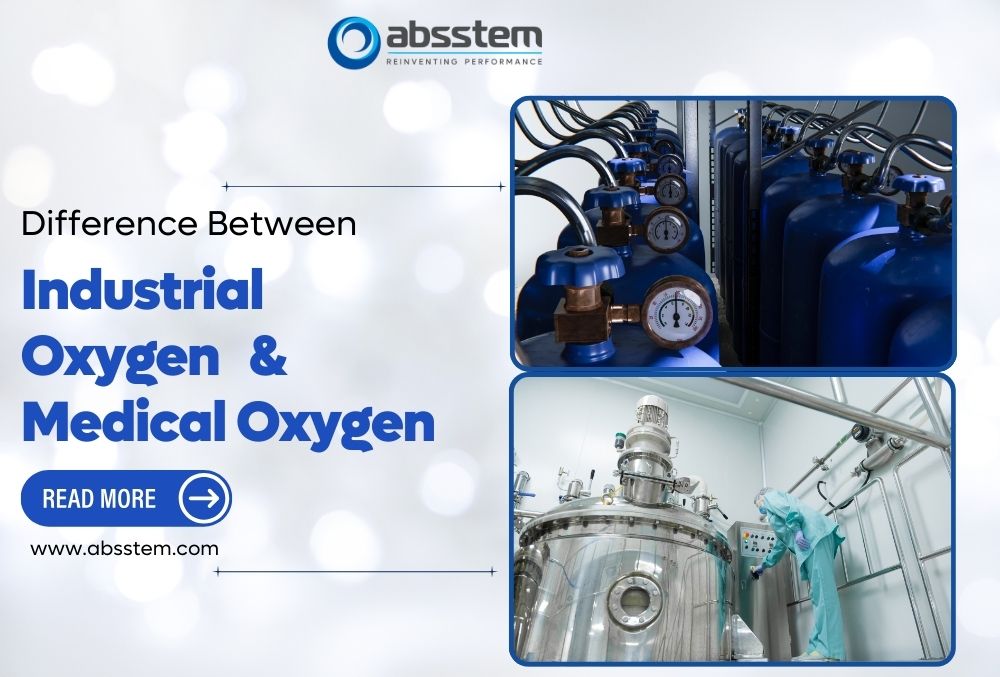Industrial oxygen and medical oxygen are both forms of oxygen, but they are produced and utilized for different purposes, each with specific requirements and standards.
Oxygen plays a crucial role in various industries and healthcare settings. The utilization of oxygen extends beyond medical applications to include industrial processes, each with distinct specifications and requirements.
This blog aims to shed light on the key differences between industrial oxygen and medical oxygen, highlighting their unique characteristics and the significance of adhering to specific standards in their production and usage.
Table of Contents
Industrial Oxygen:
Industrial oxygen is primarily produced for use in manufacturing and industrial processes. It serves as a vital component in various applications such as metal cutting, and welding, and as an oxidizer in chemical processes. The production of industrial oxygen involves separating it from the air through processes like cryogenic distillation or pressure swing adsorption.
Key characteristics of industrial oxygen:
Purity Levels:
Industrial oxygen typically has lower purity levels compared to medical oxygen. While it is still high-grade oxygen, it may contain trace impurities that are permissible in industrial applications but not suitable for medical use.
Packaging and Storage:
Industrial oxygen is often stored in larger containers, such as cylinders or tanks, to meet the demands of industrial processes. These containers are designed for the specific needs of the industry, considering factors like pressure and volume.
Standards and Regulations:
The production and distribution of industrial oxygen adhere to industry-specific standards and regulations. Manufacturers and users need to comply with safety guidelines to prevent accidents and ensure the integrity of industrial processes.
Medical Oxygen:
Medical oxygen, on the other hand, is manufactured with the sole purpose of meeting the breathing needs of patients in healthcare settings. It is a critical component in the treatment of various medical conditions, including respiratory distress, surgery, and emergency situations.
Key characteristics of medical oxygen:
Purity Levels:
Medical oxygen is produced with higher purity levels, often exceeding 93%. This ensures that the oxygen delivered to patients is free from contaminants and meets the stringent quality standards set for medical gases. As per Indian or European pharmacopeia, concentration of CO2 and CO shall be less than 300 and 5 PPM respectively to be certified as medical grade oxygen whereas industrial oxygen has nothing to do with presence of CO2, CO or other gases in it.
Packaging and Storage:
Medical oxygen is packaged in smaller, portable cylinders suitable for use in hospitals, clinics, and ambulances. These containers are designed with patient safety and ease of use in mind, allowing for controlled and precise administration.
Standards and Regulations:
The production, distribution, and use of medical oxygen are strictly regulated to guarantee the safety and well-being of patients. Compliance with medical gas standards, such as those outlined by pharmacopoeias and health authorities, is imperative to ensure the quality of medical oxygen.
Also read – An Introduction to the Most Important Gas, Oxygen and it’s Uses
Conclusion:
While both industrial oxygen and medical oxygen are essential in their respective applications, it is crucial to recognize and uphold the distinctions between the two. Understanding these differences is vital for manufacturers, distributors, and end-users to ensure the safe and effective use of oxygen in both industrial and medical settings. Adherence to quality standards and regulations is paramount in safeguarding human health and the integrity of industrial processes.
Related posts:
- The Vital Role of Oxygen Plants in Hospitals | Ensuring Patients’ Health and Safety
- The Importance of PSA Oxygen Generators in Medical Applications
- The Critical Role of PSA Oxygen Generators in Medical Facilities
- Medical Oxygen Generator In India, Oxygen Plant For Hospital
- Safety Measures To Consider When Working With PSA Generators


